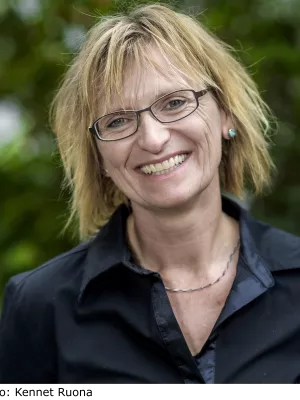
Natascha Kljun
Professor

Spatial heterogeneity of soil carbon exchanges and their drivers in a boreal forest
Author
Summary, in English
Boreal forests have a large impact on the global greenhouse gas balance and their soils constitute an important carbon (C) reservoir. Mature boreal forests are typically a net CO2 sink, but there are also examples of boreal forests that are persistent CO2 sources. The reasons remain often unknown, presumably due to a lack of understanding of how biotic and abiotic drivers interact to determine the microbial respiration of soil organic matter (SOM). This study aimed at identifying the main drivers of microbial SOM respiration and CO2 and CH4 soil chamber-fluxes within dry and wet sampling areas at the mature boreal forest of Norunda, Sweden, a persistent net CO2 source. The spatial heterogeneity of the drivers was assessed with a geostatistical approach combined with stepwise multiple regression. We found that heterotrophic soil respiration increased with SOM content and nitrogen (N) availability, while the SOM reactivity, i.e., SOM specific respiration, was determined by soil moisture and N availability. The latter suggests that microbial activity was N rather than C limited and that microbial N mining might be driving old-SOM decomposition, which was observed through a positive correlation between soil respiration and its δ13C values. SOM specific heterotrophic respiration was lower in wet than in dry areas, while no such dependencies were found for chamber-based soil CO2 fluxes, implying that oxygen depletion resulted in lower SOM reactivity. The chamber-based soil CH4 flux differed significantly between the wet and dry areas. In the wet area, we observed net CH4 emission that was positively related to soil moisture and NH4+-N content. Taken together, our findings suggest that N availability has a strong regulatory effect on soil CO2 and CH4 emissions at Norunda, and that microbial decomposition of old-SOM to release bioavailable N might be partly responsible for the net CO2 emission at the site.
Department/s
- Centre for Environmental and Climate Science (CEC)
- BECC: Biodiversity and Ecosystem services in a Changing Climate
- MERGE: ModElling the Regional and Global Earth system
- MEMEG
- Microbial Ecology
- Dept of Physical Geography and Ecosystem Science
Publishing year
2022-07-20
Language
English
Publication/Series
Science of the Total Environment
Volume
831
Links
Document type
Journal article
Publisher
Elsevier
Topic
- Environmental Sciences
Keywords
- Carbon dioxide and methane flux
- Geostatistics
- Microbial respiration
- Nutrients
- Soil organic matter
- Spatial heterogeneity
Status
Published
Research group
- Microbial Ecology
ISBN/ISSN/Other
- ISSN: 1879-1026